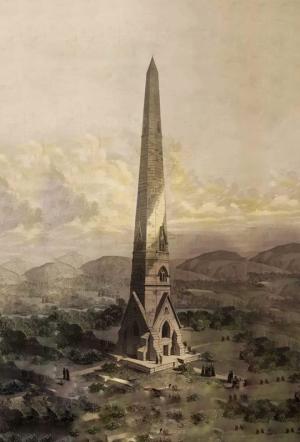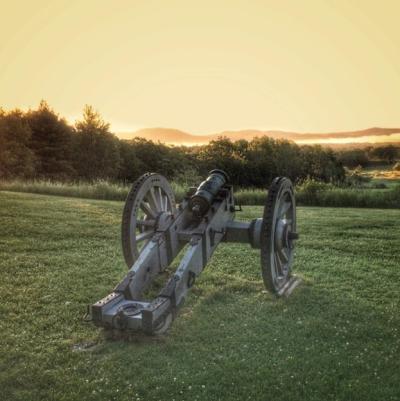Explore Saratoga’s living legacy, where rolling fields, cannon echoes, and untold stories bring America’s pivotal Revolutionary War triumph to life for today’s heritage travelers.
“It recounts the two stages of the battle of Saratoga (Sept. 19 and Oct. 7, 1777), arguably this nation’s most important military triumph. Victories at Gettysburg and Midway hastened the probable defeat of grave threats to the nation. Saratoga, by bringing France into the war on America’s side, assured the nation’s survival beyond infancy.”
—George F. Will, writing this week in the Washington Post about the new book The Fate of the Day by Rick Atkinson, a Pulitzer Prize-winning author.
When George F. Will—syndicated columnist, television personality, and one of the most widely read public intellectuals alive—compares Saratoga to Gettysburg and Midway, it’s more than high praise. It’s a wake-up call. For too long, the 1777 Battles of Saratoga have remained under-celebrated, even as they changed the course of American history. Will’s quote doesn’t just elevate Saratoga; it reminds us of its place at the heart of the American experiment.

What Made Saratoga So Decisive?
If Gettysburg was the high-water mark of the Civil War, and Midway the keystone in the Pacific, then Saratoga was the turning point of the Revolution.
The Battles of Saratoga—Freeman’s Farm (Sept. 19), Bemus Heights (Oct. 7), the siege that followed, and the eventual surrender of General Burgoyne on October 17—were not isolated incidents. They were a chain reaction that signaled the world that the American cause wasn’t a fleeting rebellion. It was a real revolution. And France noticed.
When French diplomats read of Burgoyne’s surrender, it provided the final push to form a military alliance with the fledgling United States. The might of the French Navy, arms, and funds became available—without which independence may have died on the vine.
Why It Matters—Especially Now
We’re approaching the Semiquincentennial—America’s 250th anniversary. And yet, even as other places gear up with reenactments, classroom toolkits, and promotional tourism campaigns, Saratoga’s story remains too often overlooked. That’s changing.
The Saratoga250 initiative ensures the region’s Revolutionary War heritage is honored and activated. We're building immersive, interactive experiences—where families can stand in the very fields where patriot militias turned the tide of world history.

Heritage Tourism Rooted in Place
Saratoga blends deep history with breathtaking views. Rolling ridgelines, 18th-century encampment sites, wooded ravines—these aren’t just backdrops. They are primary sources.
Like walking through the ruins of Pompeii or standing before the Normandy bluffs, visiting Saratoga invites a full-body connection to the past. And that’s what makes heritage tourism here so powerful: it's not passive. It's felt.
We don’t want visitors just to read interpretive signs. We want them to listen to musket drills, see the smoke rise over Freeman’s Farm, and feel the crunch of October leaves underfoot as they follow the trails of Morgan’s riflemen.
Top Destination for Revolutionary War Travelers
Massachusetts has the Freedom Trail, preserving the stories of Boston and Paul Revere. Now, we’re working to ensure that Saratoga County is fully recognized as an essential stop on the Semiquincentennial map.
Think of it like planning a national parks trip: you wouldn’t skip Yellowstone. Why skip Saratoga?
From our partnerships with reenactor groups to our efforts to secure federal recognition and expanded heritage funding, this is just the beginning. Saratoga is emerging as a top destination for Revolutionary War enthusiasts and a national beacon of historical memory.
Honoring Those Who Came Before
One of the most moving aspects of our work involves recognizing the veterans of 1777—not just the generals but also the foot soldiers, scouts, medics, Royalists, and camp followers. We map gravesites, document untold stories, and create digital archives for descendants, genealogists, and heritage tourists.
And yes, we're confronting the whole story—including those enslaved, displaced, or silenced by history. To understand Saratoga's triumph, we must also acknowledge its costs.

Plan Your Visit
Whether you’re a history-loving explorer, a parent planning an educational trip, or a reenactor looking to walk in the footsteps of the past; there’s no better time to come to Saratoga. The field awaits you. The story is alive. And you are a part of it. Interactive exhibits, guided battlefield tours, reenactments, and heritage trails—all being developed under the Saratoga250 initiative. Stand where America’s fate was decided. Reflect. Connect. And be inspired.
Sean Kelleher, Saratoga Town Historian and Vice Chair of the Saratoga County 250th Commission, combines genealogical research with heritage tourism planning to create immersive, place-based experiences. Kelleher was the vice chair of Battle Road 2000, the 225th anniversary of Through his Past's Paths Substack, he shares insights that bridge family history with public memory. As a Commissioner for the Erie Canalway National Heritage Corridor and a board member of the Saratoga County History Center, Kelleher helps families explore their roots while advancing heritage tourism initiatives that bring Saratoga’s Revolutionary War legacy to life.

